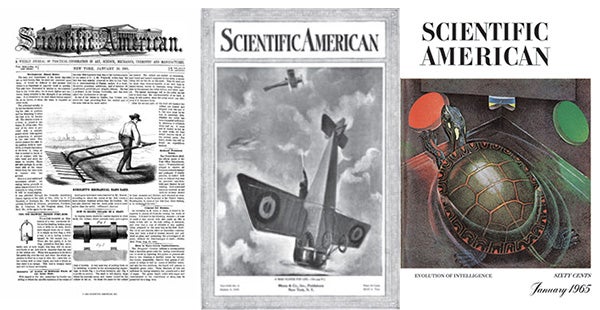January 1965
Synapse Transmission
“Since we do not know the specific transmitter substance for the vast majority of synapses in the nervous system we do not know if there are many different substances or only a few. The only one identified with reasonable certainty in the mammalian central nervous system is acetylcholine. We know practically nothing about the mechanism by which a presynaptic nerve impulse causes the transmitter substance to be injected into the synaptic cleft. Nor do we know how the synaptic vesicles not immediately adjacent to the synaptic cleft are moved up to the firing line to replace the emptied vesicles. It is conjectured that the vesicles contain the enzyme systems needed to recharge themselves. The entire process must be swift and efficient: the total amount of transmitter substance in synaptic terminals is enough for only a few minutes of synaptic activity at normal operating rates.—Sir John Eccles”
Eccles was a co-winner of the 1963 Nobel Prize in Physiology or Medicine.
January 1915
Feeble-Minded?
“The tendency toward crime may exist in the presence of a brilliant intellect, as it very frequently does, and we are unable to detect it with any degree of accuracy; the measuring scales only determine the intellectual power, that is, the ability to think, to reason, to judge, to adjust one's self to the social requirements of the world around him and to exist harmoniously in it, in conformance to its laws and customs, exclusive of vicious tendencies, which last cannot be detected by the mere gauging of intelligence. The purpose of our mental measuring scale at Ellis Island is the sorting out of those immigrants who may, because of, their mental make-up, become a burden to the State or who may produce offspring that will require care in prisons, asylums, or other institutions.”
On supporting science journalism
If you're enjoying this article, consider supporting our award-winning journalism by subscribing. By purchasing a subscription you are helping to ensure the future of impactful stories about the discoveries and ideas shaping our world today.
A Bird with Teeth
“It has been shown, beyond all manner of doubt, that Hesperornis was an immense cretaceous diver or loon. In the United States National Museum there is a mounted restoration of the skeleton and its parts, which shows very correctly the swimming posture. The fossils were obtained back in 1870 near Smoky Hill River in western Kansas.”
Piltdown Skull
“The most conspicuous feature of this skull, when seen from the side, is the low roof or dome and the slight development of the brow-ridges. The face must have presented an extremely ape-like appearance, owing to the enormous size of the jaws. The nasal bones, however, were negroid, not ape-like. The really ape-like characters are concentrated in the lower jaw. So much so is this the case that there are some who have gone to ridiculous lengths to show that this was really that of an ape, and had nothing to do with the skull. Needless to say such opinions were expressed only by those unfamiliar with the problems of comparative anatomy, and palaeontology.—Prof. W. P. Pycraft, British Museum, London”
The Piltdown fossils were conclusively proved as a hoax in 1953.

January 1865
Safety Match
“A lucifer match is now in the market that differs from anything hitherto in existence. Upon the side of each box is a chemically prepared piece of friction-paper. When struck upon this, the match instantly ignites; when struck upon anything else whatever, it obstinately refuses to flame. You may lay it upon a red-hot stove, and the wood of the match will calcine before the end of it ignites. Friction upon anything else than this prepared pasteboard has no effect on it. The invention is an English one, and by special act of Parliament, the use of any other matches than these is not permitted in any public buildings. There is not a particle of sulphur in the composition of the lucifers in question.”